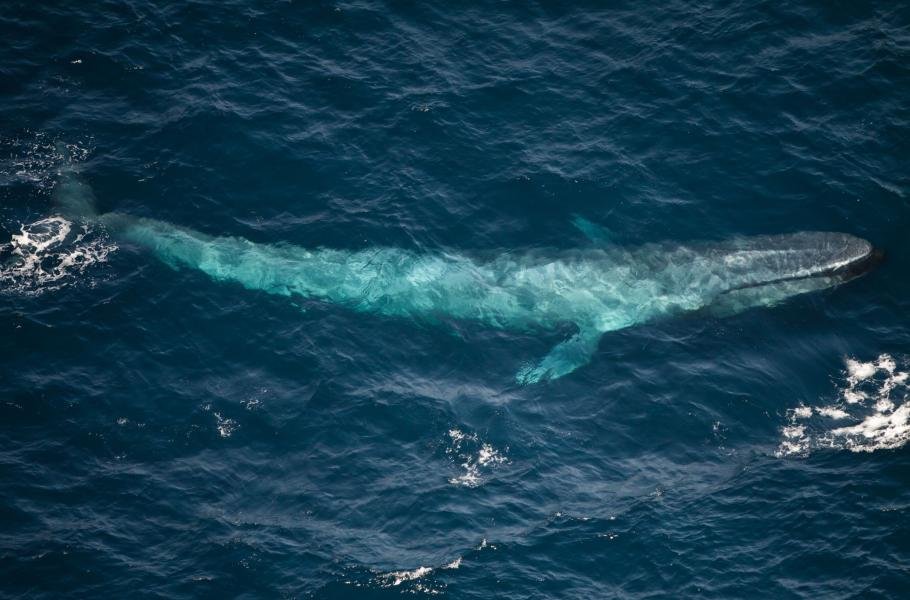Everyone probably knows that the largest land animal today is the elephant, but record holders in the category of birds, reptiles or amphibians have considerably less publicity. The long-extinct giants of the past also deserve attention.
The largest mammal today is also the largest known animal of all time, the cetacean baleen whale (Balaenoptera musculus). It is a record holder only in terms of weight, as its maximum recorded length of 33.6 meters was easily surpassed by several Mesozoic dinosaurs. But apparently no land creature has ever come close to weighing 190 tons. On land, the largest mammal and also the largest terrestrial animal today is the African elephant (Loxodonta africana) with a maximum recorded weight of 12.2 tons and a height of 4 meters at the withers. Even taller is the giraffe (Giraffa camelopardalis), whose record measured individual reached a height of 5.87 meters.
Unbeatable colossi
The largest land mammal of past geological periods was the giant Tertiary Asian ungulate Paraceratherium. This rhinoceros-related giant reached five meters in height at the back, had a one and a half meter long head and was over 8 meters in length. Its weight was up to 16 tons, so it weighed the same as three large elephants!
Currently, the largest living feathered bird is the African two-toed ostrich (Struthio camelus) with a height of up to 2.7 meters and a weight of at least 156 kilograms (data on individuals weighing around 200 kilograms are not confirmed). The eggs of these birds are also the largest you can see in nature today, weighing up to 1.4 kg. The migratory albatross (Diomedea exulans) can currently boast the largest wingspan of around 3.7 meters. Of the large birds of prey, the most impressive is the South American Andean condor, whose wingspan can exceed 3.2 meters.
The Madagascar „elephant bird“ Aepyornis maximus was probably among the largest prehistoric birds. At a height of over 3 meters, it weighed up to around 500 kilograms, roughly three times the weight of the largest ostriches. The giant teratoma Argentavis magnificens, which lived 6 million years ago in what is now Argentina, had the largest wingspan. His outstretched wings measured up to eight meters!
XXL size reptiles
The golden age of reptiles of the Mesozoic period cannot be repeated by the current ecosystems even in the field of size. Nevertheless, even today there are giant reptiles, among which the clear record holder is the sea crocodile (Crocodylus porosus) living in Australia and Southeast Asia. Its average length is 4–5.5 meters, but the record individual reached a length of 6.3 meters and a weight of almost 1.4 tons. However, the longest – although not nearly as heavy – reptile is the reticulated python (Python reticulatus) also from Southeast Asia. The longest known individuals reportedly reached a length of about 9.7 meters, but the confirmed measurement is „only“ 6.95 meters. With a maximum length of 6.6 meters, the South American large anaconda (Eunectes murinus), which is also considerably more powerful, is not far behind. Among today’s turtles, the large leatherback (Dermochelys coriacea) reigns supreme with a length of up to 2.7 meters and the highest recorded weight of 932 kilograms.
In the category of reptiles of all time, the absolute winner is clear – it is the giant sauropod dinosaur Argentinosaurus huinculensis. It lived in the Upper Cretaceous period 95 million years ago, reached a length of around 35 meters and a weight of over 80 tons. However, fragmentary fossils point to the existence of even larger dinosaurs, about which we do not yet know much.
Amphibious giants
Although the era of nine-meter-long prehistoric amphibians has long since ended, even in today’s nature it is possible to come across unusually large species. The record holder is the Chinese newt (Andrias davidianus) from Southeast Asia, which grows up to 183 cm in length and weighs 64 kilograms. The Japanese giant salamander (Andrias japonicus) is similarly large, with a maximum length of 153 cm and a weight of around 36 kilograms. The largest living frog today is the giant leapfrog (Conraua goliath) from Cameroon and Equatorial Guinea. This fascinating „frog“ weighs up to 3.2 kilograms and has a body length of 33 cm, not counting the legs. Legless worms are also a special group of amphibians, the largest representative of which today is the Thompson’s Caecilia species (Caecilia thompsoni) from Colombia with a length of up to 1.5 meters and a weight of around 1 kilogram.
Probably the largest amphibian in the history of life on Earth was the temnospondyl Prionosuchus plummeri. This nine-meter-long giant lived in the Permian period (about 270 million years ago) in what is now Brazil. The all-time record frog was the „toad from hell“ Beelzebufo ampinga. She lived in Madagascar 70 million years ago, without legs she was 40 cm long and weighed over 4 kilograms. She could even eat baby dinosaurs!
Goliaths among fish
If we do not count fish with a cartilaginous skeleton, which also includes large sharks and stingrays, then the largest living fish at the moment is the strangely shaped luminous moonfish (Mola mola). It has a fin span of up to 4.2 meters, a body length of 3.3 meters and a weight of around 2,300 kilograms.




